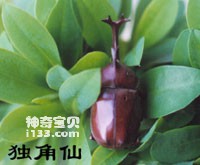Rhinocerosidae, also known as Rhinocerosidae, is a group with distinctive characteristics. The upper jaw is more or less exposed and can be seen on the back. The upper lip is covered by the lip base; the antennae have 10 segments and the gills have 3 segments; the prothorax, abdomen and base are Characteristics such as cylindrical, triangular, tongue-shaped and other vertical processes appear between the nodes, making them easy to identify. Sexual dimorphism is evident in many large to extra-large species. Males have strong horns or other protrusions or pits on their heads and pronotum, while females have simple or visible low protrusions. There are more than 1,400 species of rhinoceros beetles recorded in the world. Relatively speaking, the species of rhinoceros beetles in my country is quite poor, with only 33 species recorded so far. The adults are herbivorous, while the larvae are mostly carrion-feeding, or they may damage the roots of crops and trees underground. Although there are few species in our country, there are many important underground pest species with great economic significance.

Allomyrina dichotoma (Linnaeus), also known as the two-pronged rhinoceros beetle, is large and mighty. Excluding the horns on its head, its body is 35-60 mm long, 18-38 mm wide, oblong in shape, and has a very arched ridge. The body is chestnut brown to dark brown, and the head is small; the antennae have 10 segments, of which the gills are composed of 3 segments. Male and female dimorphism: The male has a bifurcated angular process at the top of the head, a bifurcated angular process at the front and back of the pronotum, and a smooth and shiny back. The female is slightly smaller, with no angular processes on the cephalothorax, but a bulge in the center of the head and 3 small transverse processes. There is a T-shaped groove in the center of the front of the pronotum, and the back is thicker and darker. The three pairs of long legs are powerful and have a pair of claws at the end, which are powerful tools for climbing.
There is one generation of unicorns in a year. The adults usually appear from June to August every year. They are mostly nocturnal and diurnal. They have certain phototaxis. They mainly feed on the sap from the wounds of trees or ripe fruits. They are basically not harmful to crops and trees. cause harm. The larvae feed on dead wood and decaying plant matter, so they often live in the rotten core of trees, sawdust piles, fertilizer piles and garbage piles, and even on the roofs of thatched houses. Does not harm crops and trees. The larval stage molts twice and lasts for 3 instars. The mature larvae are very large, milky white, about the size of an egg, and usually curved in a "C" shape. Mature larvae pupate in the soil. The unicorn fairy is widely distributed in Jilin, Liaoning, Hebei, Shandong, Henan, Jiangsu, Anhui, Zhejiang, Hubei, Jiangxi, Hunan, Fujian, Taiwan, Guangdong, Hainan, Guangxi, Sichuan, Guizhou, and Yunnan; abroad there are North Korea, Distribution records in Japan. It is especially common in areas with developed forestry and lush trees.
In addition to being used for ornamental purposes, the unicorn fairy can also be used as medicine to treat diseases. The male worms used in the medicine are caught in summer, scalded to death with boiling water and dried or dried for later use. The traditional Chinese medicine name is unicorn beetle, which has the functions of calming convulsions, breaking blood stasis and relieving pain, attacking toxins and laxative.
In 1976, someone extracted dicotastin from Dictoralis sibiricum. It has certain anti-cancer effects, is highly active against solid tumors W-256 ulcers, and has marginal activity against P-388 lymphoid leukemia.
The rhinoceros species is rich in resources and deserves in-depth exploration and development.
animal tags: Rhinocerosidae
We created this article in conjunction with AI technology, then made sure it was fact-checked and edited by a Animals Top editor.